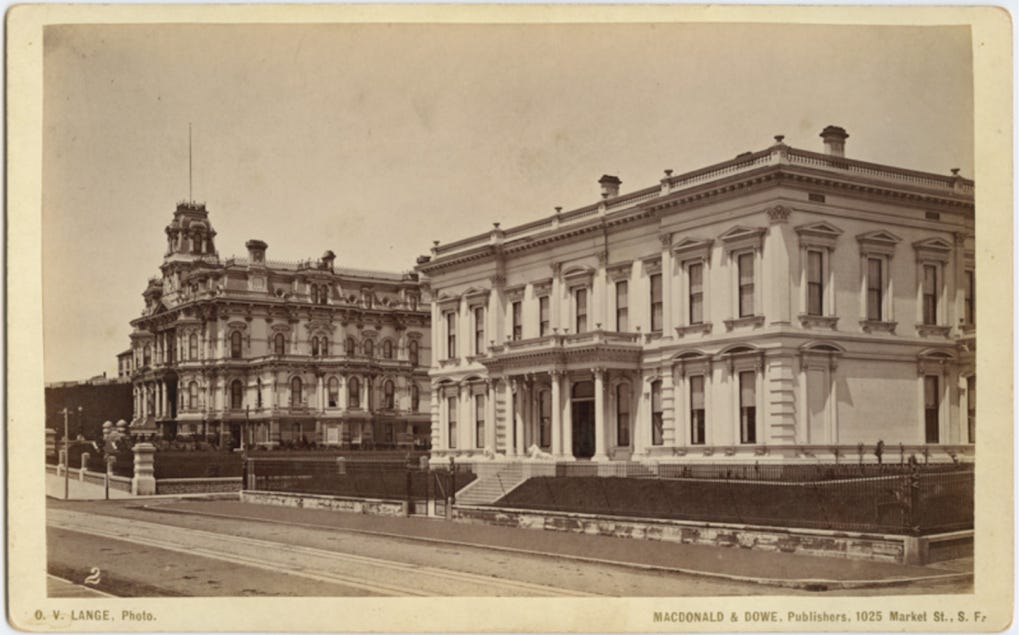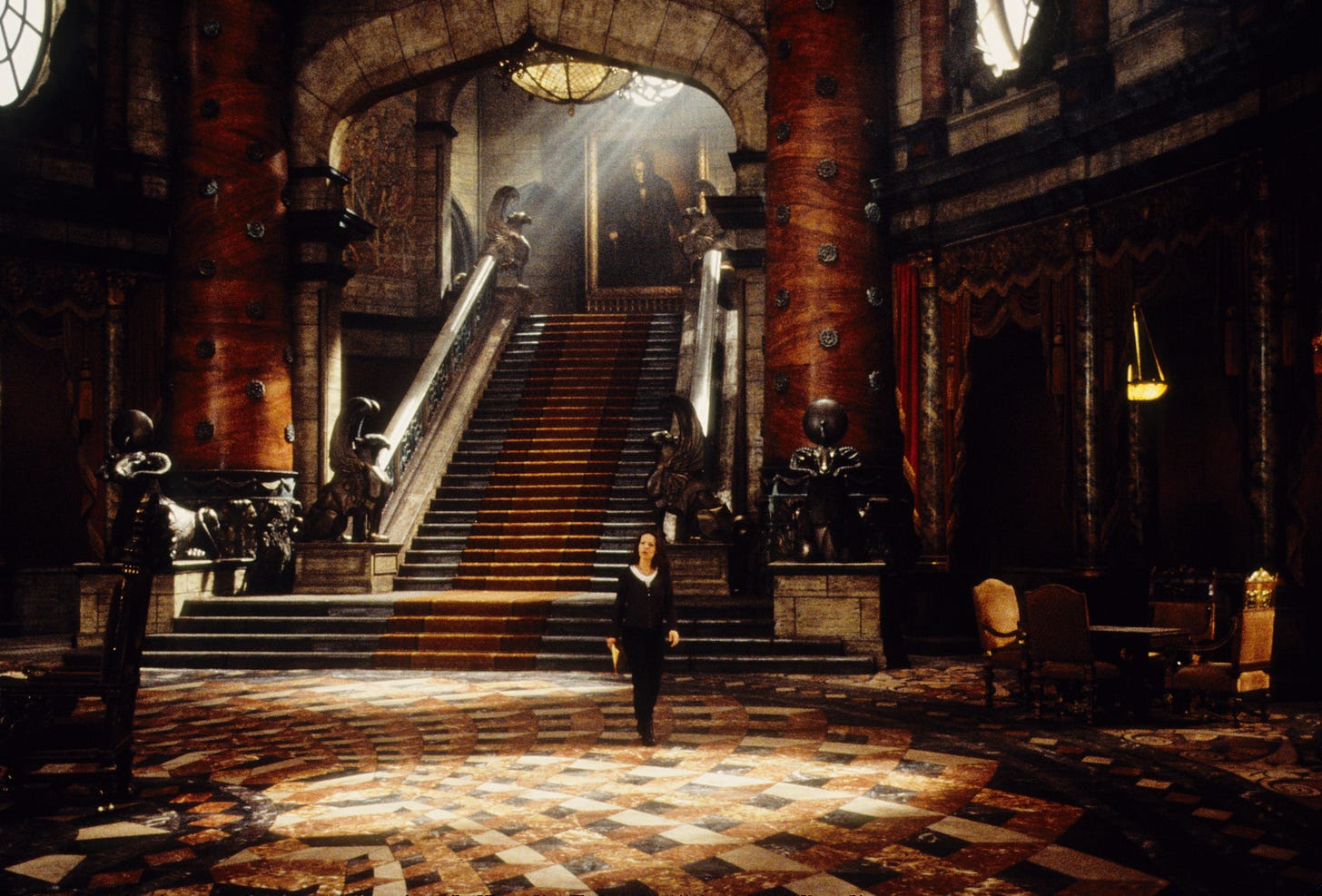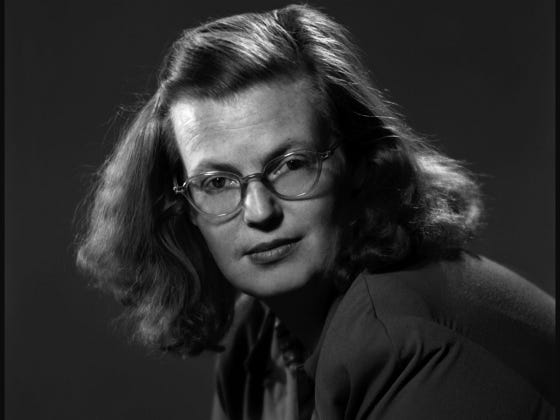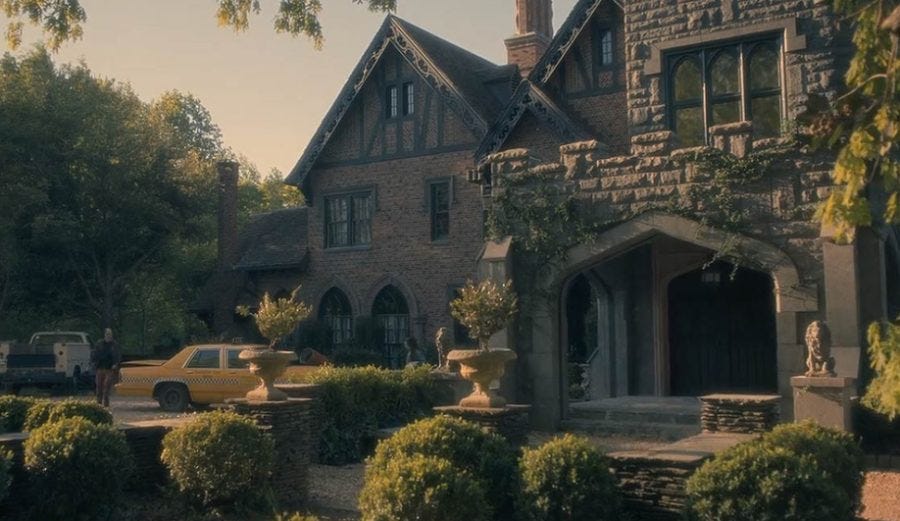Happy Halloween, worms. This essay is the first of four in the Bookworm series, which focuses on horror films (in this case, a TV series) adapted from books. Bookworm is made possible by the Rocky Wood Memorial Scholarship Fund from the Horror Writers’ Association. This essay is also possible thanks to Ruth Franklin’s biography of Shirley Jackson, ‘A Rather Haunted Life,’ which was so rich with detail that I ended up writing/thinking far more about the author’s life than I intended. Be forewarned: it’s a long one!
By: Elizabeth Lepro
“People have to live and die somewhere, after all.”
- ‘The Haunting of Hill House,’ Shirley Jackson
What haunts a house? Generally, we attribute a haunting to ghosts of a building’s insidious past: murder, torture, enslavement, repression, sexual transgression, greed, and myriad other sins by or against the family unit. A house can hold one-thousand secrets. For that reason, they have time and again made apt metaphors for generational trauma, or for that warm and fuzzy, walled-in feeling of going completely insane.
Hill House is a foundational haunted house — perhaps the foundational haunted house. In Shirley Jackson’s 1959 novel ‘The Haunting of Hill House,’ a doctor of philosophy sets out to study poltergeist phenomena and invites two women, Eleanor, called Nell, and Theodora, to join him in the mansion as “assistants.” His intent is really to see how these women — both of whom have encountered the paranormal in their lives previously — will react to the houses’ particular charms. Also along for the ride is Luke, a relative of Hill House’s proprietors. While staying at Hill House, Nell, Luke, Theodora, and Dr. Montague are subject to increasingly intense hauntings, namely a violent banging on the walls and doors each night. But it is Nell who experiences the most isolating — and ultimately fatal — haunting.
That story and its titular house have since spurred two feature films, a TV series, and a play, not to mention countless haunted houses in the imaginations of other writers and filmmakers. But Jackson’s Hill House doesn’t quite align with our aforementioned understanding of haunted houses. To set off its cursed history, no horror needed to occur within Hill House’s walls; the building was born bad.
By Jackson’s original description, Hill House is a “masterpiece of architectural misdirection.” Every angle in the house is not quite 90 degrees. Its steps are purposefully un-level. Each doorway — and there are many, many doorways — is a tad off-center, meaning doors always swing shut unless they are held open. A maze of narrow passages and interconnected rooms twist around the inside of the structure like concentric intestines, so that once you’ve reached the center of the home, natural light is an impossibility and disorientation a guarantee. A statue can only remain standing in Hill House if it’s been specifically weighted to offset the imbalance of the floor. Likewise, anyone who enters Hill House with intent to stay is required to recalibrate and submit to the house’s slanted reality.
“Hill House is vile,” Jackson writes, through the lens of her characters. “Diseased,” “leprous,” “disturbed,” “sick,” a “place of contained ill will.”
What Jackson asks us to consider is not just the house-as-metaphor, but as a legitimate object and subject in its own right. Consider a house, she urges, designed precisely to inspire in its inhabitants a sense of cerebral disorder. Consider a house that becomes haunted not against its maker’s best intentions, but because of them. Consider a house built not to shelter a family, but to trap them.
Once we’re able to imagine this kind of house, sidled up against the darkened hills, she pushes us further — decades further. What of the people who choose to live inside such a house? Not necessarily those who, against their better judgment, wash up on its murky shores, but that slim percentage of people who enter the house and, knowing its design, decide to stay. These are the people for whom a bad house becomes a siren call. Or, a home.
Shirley Jackson’s grandfather Samuel C. Bugbee built houses for wealthy families in the San Francisco hills — elegant, opulent “millionaires’ palaces” for post-Gold Rush robber barons. “It is hard to imagine more potent symbols of gilded-age excess than the Nob Hill Bugbee mansions,” writes Ruth Franklin in her seminal biography of Jackson. These mansions were considered cursed from the start. “Lifeless and forlorn,” the Morning Call said of the Nob Hill mansions in 1891, “they tell no story but of pride ungratified and happiness that could not be purchased. So the shadows seem to rest on Nob Hill.”
True to their infamy, the mansions burned down in the early 1900s. But Jackson’s family would go on to form Bugbee & Sons, a firm responsible for the construction of the California Theater, Wade Opera House, and the Golden Gate Park Conservatory.
Given this familial inclination for home-building and Jackson’s own domestic life — she would become a wife and mother of four, who also wrote essays about parenting — she composed her fiction primarily in, around, and about houses. “She delighted,” writes Franklin, “in putting a domestic twist on the supernatural.”
Jackson spent the earliest years of her childhood in California, which she describes in dreamy scenes of eating pomegranates on fenceposts and delightfully pinching rosebuds on the bush in her garden each spring. But in high school, Jackson’s family moved to Rochester, New York, and into a “handsome five-bedroom colonial with Tudor accents,” by Franklin’s description. Her parents had their sights set on joining the local elite. Meanwhile, Jackson was stewing. “Golly, how I hate this town,” she wrote in her diary.
This was 1933 — interestingly, around the time that Halloween-themed haunted house attractions began to crop up in the U.S. Though Jackson’s well-off family might not have felt it, the country was in the swings of the Great Depression and it was fantasy towns like the ones the Jackson family lived in that must have moved her to write stories like ‘The Lottery,’ in which everything that seems perfect on the surface is actually simmering with horror underneath.
Criticized endlessly by her mother, ignored by crushes, rejected from sororities, witness to racism and anti-Semitism pre-WWII, young Jackson learned in Rochester what some of those Nob Hill families must have discovered, too: happiness cannot be purchased. Later, Jackson likely reflected on the gigantic luxury homes her family had wrought as delirious vestiges of a more excessive time, when no dream seemed too big for a house to contain it.

In all adaptations, ‘The Haunting of Hill House’ begins with a desire for the house. Dr. Montague, a self-proclaimed student of supernatural manifestations, has been “looking for an honestly haunted house all his life.”
Eleanor Vance, or Nell, meanwhile, has been cooped up in her mother’s house for 11 years, sacrificing her own life to care for the ailing woman right up until her death. When she gets the doctor’s letter inviting her to participate in the experiment, she is overjoyed. “During the whole underside of her life, ever since her first memory,” Jackson tells us, “Nell had been waiting for something like Hill House.”
In its original form, Nell’s drive to Hill House is something like Little Red Riding Hood’s journey through the woods to grandmother’s, pre-wolf. She drives along a pleasantly winding road, past quaint small towns, lush fields, and orchards. On this drive, she passes a large house with a pair of stone lions propped at its entryway, and she begins to construct a fantasy:
Time is beginning this morning in June, she assured herself, but it is a time that is strangely new and of itself; in these few seconds I have lived a lifetime in a house with two lions in front. Every morning I swept the porch and dusted the lions, and every evening I patted their heads good night… When I slept it was under a canopy of white organdie, and a nightlight guarded me from the hall. People bowed to me on the streets of the town because everyone was very proud of my lions.
This vision of a home of her own is so intense that Nell cannot see the real world through its glossy windows. Nell sacrificed her youth for her mother. She shows up at Hill House’s doorstep, that vile place, believing that it is her prize.
In haunted house films, families often pull into their new driveway on a sunny day, wide-eyed and expectant, full of hope for their new lives. The kids rush to lay claim to their rooms. The adults consider all the ways they might repaint or refresh. They roll their eyes at old wallpaper, confident in their refined, modern tastes. Only we, the watchers, know that this bliss is unsustainable. We know it as we watch Nell drive toward Hill House, just as we know it when we see the family in any haunted house film unpack their belongings. A new house — particularly a new, old house — is foreboding. Better, we think, to pack it back in the station wagon and get one of those grayscale prefabs shipped in on wheels, history-less. In slashers, we beg the teens not to go deeper into the house. In haunted house films, we beg the family not to go in at all. This house, we know, is not a warm vessel for their new future. There’s too much unrealistic hope resting on something so real.
Shirley Jackson’s mother had a significant influence on her life and work. Geraldine Jackson was a practitioner of Christian Science, an idealist faith that believes “the real universe is the spiritual expression of infinite, perfect, creative Spirit, the divine Mind; that it is infinitely good and right,” as opposed to the material world we occupy, full of greed, ignorance, fear, etc. (Christian Scientists also believe in spiritual healing, and Shirley would later reflect on watching her mother and grandmother pray over her brother’s broken leg for days before taking him to the hospital.) Geraldine was, by Zoë Heller’s description, “an elegant, rather vapid woman, who was disappointed by her daughter and who made it clear that she would have preferred a prettier, more pliable one.”
Between the mansion-builders and the Christian Scientists, Jackson’s lineage was peppered with idealists — an ancestral line dedicated to seeing the world not as it is, but as it would be in their own image.
Jackson never fit her mother’s conventional mold. She was an independent, strong-willed child who spent hours alone writing and would later in life study witchcraft. It’s clear from Franklin’s biography that Jackson struggled with her mother’s criticism, and sought, at times, to recontextualize her own life because of it. Later in her life, she placed an index card in the front of one of her teenage diaries suggesting that most of its content was affectation.
Though she may not have been able to confront her mother directly about the pervasive influence of her idealism, she certainly bucked it in her writing. After the family had moved to the East Coast, Jackson wrote in her diary about the death of her former self, the one who had existed in the sweet-scented California air. “She was a dreamer, and dreamers have no place in our matter-of-fact modern world,” Jackson wrote. An “infinitely wiser person” took her place.
It is that Jackson who eventually gravitated toward the wicked underbelly of an idealistic world. This “infinitely wiser person” wrote stories about a seemingly pleasant village carrying on its annual tradition of stoning one citizen to death, about countless women driven to madness by oppressive expectations, and, of course, about large houses full of terror and despair. In a truly un-Christian Science statement of opinion, Jackson once wrote, “I can’t understand this desire—this requirement—to hide true things, and display to the world a suave, untroubled visage. If one is bewildered and unhappy, why not show it?”
Jackson wrote ‘The Haunting of Hill House’ while raising four children in bucolic 1950s Vermont, stuck in an intense marriage to a man who cheated on her belligerently and without shame and that often left her feeling lonely and oppressed. To deal with agoraphobia and anxiety, she relied on a combination of tranquilizers, amphetamines, and alcohol.
In the novel Jackson was writing, a spirit goes marauding about the hallways every night, pounding on doors, turning baby head-shaped doorknobs, and warping walls, begging to be let into one of its many rooms. The further Nell falls into her paranoia and isolation, the more intensely she feels Hill House’s spectral presence. When the house has her firmly in its grip, she steps out of one fantasy, and into another.
“No stone lions for me…no oleanders; I have broken the spell of Hill House and somehow come inside.” “I am home,” she thinks, ascending a dangerous spiral staircase. “I am home.”
In the last chapters of Shirley Jackson’s life, she struggled immensely with mental anguish. It was in these final years — trapped in a haunted house of her own — that she, too, began to fantasize.
“i think about the glorious world of the future,” she wrote in her diary in 1964, “not to be different and weak and helpless and degraded …and shut out. not shut out, shutting out.”
On the outside, Jackson had created a vision of 1950s domestic bliss, one that undoubtedly brought her moments of happiness and comfort and that she’d dreamed of as a child. She’d cultivated a circle of literary friends, who often visited and described her as “buoyant.” She was financially successful thanks to her writing and was nominated for a National Book Award. But in her most private moments, she longed to escape the life she’d built. That longing came to fruition. Jackson died in bed of cardiac arrest on August 8, 1965, at 48 years old. She was at home.
Almost 20 years since we had last been inside Hill House, we returned to it again in 2018, this time in episodic format.
Because Mike Flanagan, who directed the Netflix series Haunting of Hill House and wrote or co-wrote many of its episodes, has “always been drawn to familial horror,” he completely renovated the guts of Jackson’s novel to create a powerful multi-character storyline that is neither indulgently faithful nor disrespectfully unfaithful to its source material. Rather than a more direct retelling of Jackson’s story — as both of the film adaptations are — the show is an adventure inside her work and mind.
The Crains, in this telling, are a husband and wife house-flipping team, who move into Hill House with their five children in the summer of 1992. Olivia Crain is the creative mind behind each renovation that her husband, Hugh, brings into reality. Their plan is to renovate the old mansion and sell it so they can build their dream house — to construct one dream in order to create another. The house, of course, doesn’t oblige and the summer ends with Olivia’s death. As the series flashes between the past and the present, we see how each of the five children are affected as adults by the time they spent as children in Hill House. One of the characters, a type-A mortician, is named after Shirley Jackson.
“We wanted a character… who took us right up to the face of death and mortality, and turned the lights on,” Flanagan told Simon Abrams of Vulture. “I felt like Jackson herself operated that way in her own life, processing social anxiety and her feelings about society by walking directly up to them and staring them in the face.”
“Shirley never wants to look,” a man tells the television character Shirley, “but Shirley has to look.”
What each of the siblings in the show are asked to do, over and over again by the ghosts of their past and present, is look — not imagine, not dream, not create, not run away, but look and see. They each resist in various ways. Theodora, for instance, a medium who can see people’s memories when she touches them, constantly wears gloves. But a truly haunted house does not allow us to look away; it demands constant attention, and when the children finally return to their haunted house, they are greeted by the same demanding, familiar ghosts of their past. In the penultimate episode, Shirley, the character, falls into a dream of her own funeral, in which a mortician leads her husband to her embalmed corpse.
“I hung flowers full of smell and posed her like a dreamer,” the mortician says. “And now, she is fixed and pretty. But underneath, she is a horror.”
Shirley Jackson began ‘The Haunting of Hill House’ by telling us that “no live organism can continue for long to exist sanely under conditions of absolute reality; even larks and katydids are supposed, by some, to dream.” It’s a formidable opening, especially in the context of the story that follows. Dreaming is a fact of life, Jackson tells us right away. Yet she spends the rest of her novel — and, in many ways, the whole of her life — excavating dreams to see what horror lay wriggling at their rotten cores.
So what did Jackson believe haunts a house? Perhaps it has nothing to do with what we can’t see, and everything to do with what we choose to ignore; what realities we sacrifice to make a dream seem real. A haunted house is born from expectations and aspirations that so often rely on a fantastic unreality — dreams of absolute safety and certainty, forever; dreams of propriety, that a house is destined for you, that its future and yours are inextricably intertwined. But dreams and nightmares live on the same spectrum; in the same state of singular unconsciousness. What’s worse, we each enter that unconscious state alone. A dream can only be shared in the metaphorical sense — in reality, whatever walks in the fantasies you create in your mind, walks alone.
Jackson knew what it was to be lonely in a house full of people. She knew that if your dream brought you to a place like Hill House, where the walls are built to keep it trapped, it would go on knocking against closed doors, banging back and forth like a pinball, turning knobs, warping the walls, and ripping the chandeliers from the ceiling, begging to be let in the rooms where the people are. You can live in a house, but you cannot live in a dream. Not, at least, without waking up in a nightmare. 🪱
Editing by the ever supportive Nicholas Gambini.
RELATED
‘Whose hand was I holding?’ Remembering ‘The Haunting’ and its scariest scene
‘The Yellow Wallpaper,’ by Charlotte Perkins Stetson








